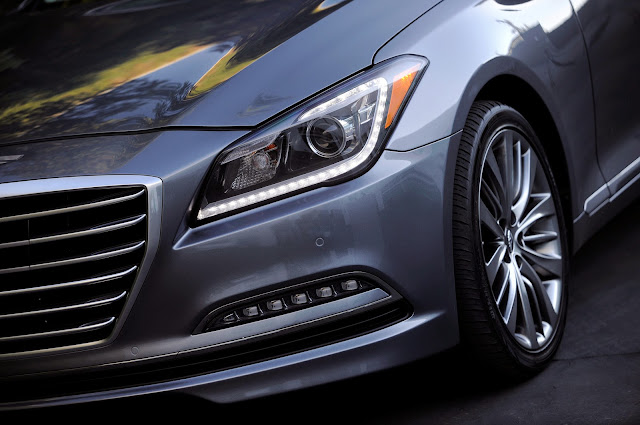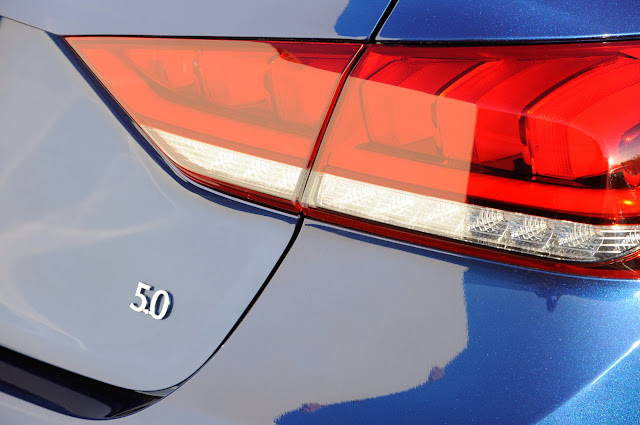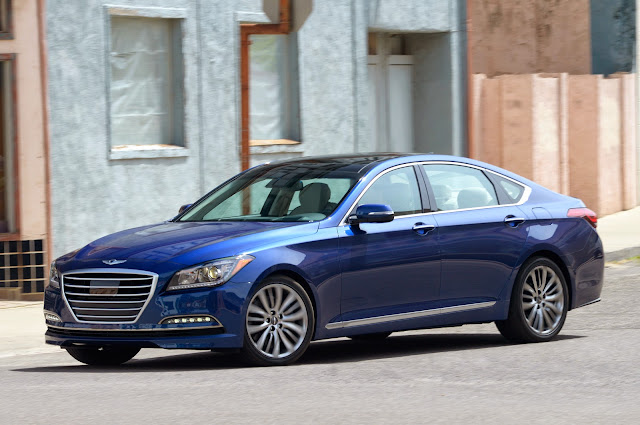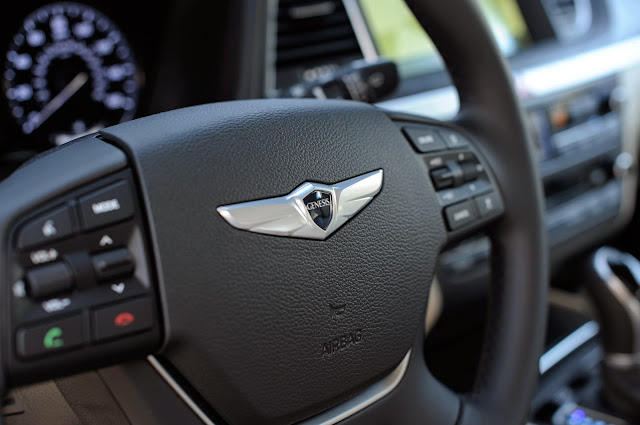
In the Beginning, Hyundai Created a Good Luxury Sedan, Now it is Better
Everyone grows up. Sometimes they mature, trading baby fat for wisdom, and they go on to live long, productive lives. Others take their worst traits and amplify them, and then spend the rest of their lives trolling the Internet, leaving mean, snarky comments they really think are important. They have not matured; they have simply gotten older.
Fortunately, the 2015 Hyundai Genesis premium sedan has taken the higher road in its second-generation. The exterior looks more refined, its handling has become a touch more sporty, and the interior more sophisticated. What this car may lack in sporty chops it more than makes up in high-tech features and a luxurious ride.
All of those extra wrinkles have been ironed out of the 2015 Genesis, which looks elegant and smooth. There’s a pronounced centerline that moves the length of the car’s body and its roofline is graceful. The Genesis sedan keeps its long hood and short rear deck, while the grille is bigger and wider. There are some nice Audi-esque cues with this car’s design, but the car maintains its own identity.
The 2015 Genesis’ HID headlights with LED turn indicators draw attention to the car and everything is laid out in long horizontal lines that make the sedan look wider. At night, a custom Genesis puddle lamp serves as a nighttime reminder that this car is special.
Hyundai did increase the car’s length by 0.2 inches, but that’s nearly negligible. However, the 2015 Genesis’ wheelbase has stretched by 2.9 inches to 118.5 inches to smooth out the ride and create more interior space. There were also some big improvements to the car’s frame and suspension. Hyundai uses more than 50 percent high-strength steel, more than any of its competitors. This improved stiffness by 40 percent and adds the car’s sportier performance. There’s an all new multi-link rear suspension and a beefed-up front suspension with aluminum shocks and greater wheel travel.
In testing cars with the 5.0-liter V-8 and the 3.8-liter V-6, I found both sedans offered a sportier ride than the outgoing version. The rack-mounted electric power steering with variable gear ratio was firmer and the body felt more stable on the road. I wouldn’t call this car nimble, but the body did not roll much in fast corners. It lacks a true road feel but handles well. Drivers will feel more confident behind the wheel, though they won’t mistake the Genesis sedan for a sports car, even if they switch to Sport mode in one of the three selectable modes that include normal, sport, and eco. Those modes adjust a number of calibrations on the vehicle such as throttle response, transmission shift points, and other features. The changes are slight, but still noticeable. The 5.0-liter model also uses a continuous dampening control system to adjust to the road.

However, when driving the 2015 Genesis V-8 sedan from Scottsdale, Az., to Los Angeles, this car was nearly perfect. It’s extremely quiet on the road, the 420 horsepower under the hood mated to a silky smooth eight-speed automatic transmission with standard paddle shifters provides more power than most people need, aggressive acceleration for high-speed passing and great cruising. The all-wheel-drive V-6 model, new to the lineup and a necessary for luxury buyers in certain regions, was also excellent, though the 311-horse 3.8-liter V-6 under the hood with the 3.8-liter felt underpowered after driving the bigger V-8.
Even entering the highway with the Genesis V-6 left me feeling confident in this car. The HTRAC all-wheel-drive system can push all of the torque to the front or the rear if that’s where the car determines where the power should go. It also incorporates the car’s electronic stability control to stop some wheel spin and push torque from the left to the right. In a demonstration, a car was parked on three rolling platforms and the one front wheel was allowed to grab traction. It quickly rolled off the platform.
Additionally, Hyundai has added a lot of technology for long hauls including adaptive cruise control and an aggressive Lane Keep Assist. The cruise control does a nice job of matching the speed of the vehicle in front and slowing down if that vehicle drops its speed. Once, I set the cruise control to 110 mph and just cruised behind a car going the speed limit.

The Lane Keep Assist uses a camera to monitor the car and make sure it is staying between the lines. If the car begins to cross a line, the system will shudder the wheel and let out an audible beep. (It does this as well with the blind-spot detection system.)
There’s a more aggressive setting for the Lane Keep Assist, which actually steers the car back into the lane and forces you to fight it though the lane if you want to cross over it. You can actually let go of the wheel and watch the car turn through a corner in a very disturbing way. But you can only let go of the wheel for 15 seconds before the system announces it will shut down and you need to grab the wheel. It wasn’t engineers who devised this system, but rather lawyers who want the driver to still be responsible for the vehicle’s trajectory. The steering corrections at times were too harsh and sometimes it rushed a sense of panic through me. Other times, I was fascinated by the car steering itself.
The system demonstrates how close automakers are to autonomous driving and how much lawyers, not engineers will keep back-seat driving off of the road.

The system demonstrates how close automakers are to autonomous driving and how much lawyers, not engineers will keep back-seat driving off of the road.
However, that backseat wrapped in leather is pretty comfortable. All of the seats are pretty comfortable for that matter. There’s certainly a lot of space with an interior volume of 123 cubic feet. That beats the Cadillac CTS (110.7 cubic feet), the Lexus GS (113.3 cubic feet) and the Mercedes E Class (113.1 cubic feet). More importantly, it feels spacious and open and the ride is insanely quiet, even quieting the big V-8.
Inside the 2015 Genesis, there’s also a rear window shade that can be electronically drawn up or down, nicely done real wood trim with different grains on different vehicles, and the instrument cluster is clean and precise. The little details are executed very well in this cabin in both construction and choice of materials. Hyundai has done some ergonomic work on the steering wheel and many of the switches have been replaced to give them a better feel.
There’s a standard 8-inch screen with navigation (as well as an optional 9.2-inch high definition screen available). Both are touch screens, though there’s also a control wheel that makes navigation easier. There’s only one USB port at the base of the center stack and it’s a little awkward to use, but if you need to charge more than one thing at a time, just get a 12V plug with USB ports for additional charging needs.
It only takes a few minutes to adjust to everything inside this car, from connecting your phone to turning on your seat heater and turning off the Lane Keep Assist. The car is laid out in a very driver-friendly manner with no surprises or disappointment. All of the boxes have been checked.
Perhaps the most intriguing feature is the automatic trunk opening. It sounds more like a gimmick than anything else but it’s certainly something your neighbor is going to show you if he buys a Genesis. Just walk up to the back of the car, wait to hear four beeps and the trunk opens. No foot waving or button pushing, it just opens like it is reading your mind. Very cool.
But Hyundai has always provided owners something to boast a little about. More to the point, though, owners will be bragging about the purchase price. Starting at $38,950 and arriving loaded up with features, the Genesis remains a great near-luxury purchase with all of the trappings of much more expensive cars. It’s understated in all of the right ways and still a deal. Who doesn’t like a deal? BMW owners?
Add to that all of the enhancements this car undergoes, the Genesis sedan has matured very nicely.
Source:
By Scott Burgess | April 06, 2014
2015 Hyundai Genesis Sedan : First Drive



0 komentar:
Post a Comment